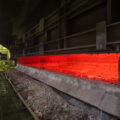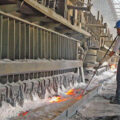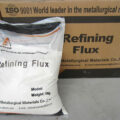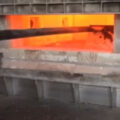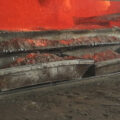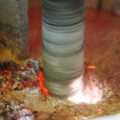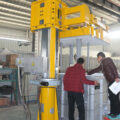The basic principle of impurity removal is to use the difference between the density and viscosity of the impurity and the aluminum melt to separate the impurity from the aluminum melt by adding certain elements or using physical methods. Specific methods for impurity removal include filtration, electric flux, electromagnetic purification, and flux refining methods. Filtration purification method is a commonly used method in the impurities removal of molten aluminum. Currently, the commonly used filters include mesh filters, CFF filters, particle filters and porous ceramic filters.

The filter media filtration also gradually transitioned from a single ceramic foam filter to a porous ceramic tube. However, due to the continuous use of the filter, more and more impurity particles are deposited, blocked and adsorbed in the filter channel. When it accumulates to a certain extent, under the condition that the total flow through the filter remains unchanged, the flow rate of the liquid metal increases due to the decrease of the filter channel, and the energy applied to the inclusion particles increases. As a result, the adsorbed inclusion particles are easily deposited. It is flushed back into the liquid metal again, reducing the filtration efficiency. Therefore, the filtration purification method is rarely used alone, and is usually only used to remove large inclusions or the inclusion content in the aluminum liquid above the millimeter level.
The electric flux purification method is a method of purifying molten aluminum used in the aluminum processing and production of the Soviet Union in the 1970s. The aluminum melt passes through the molten flux layer applied with a DC or AC electric field, and the suspended non-metallic inclusions and intermetallic compounds are removed under the action of the electric field and the flux. During electric flux refining, the heat generated by the current heats the flux to the required temperature. And since the molten metal and the flux form an electric circuit, the refining process is strengthened under the action of the electric field.

Electromagnetic purification is a new type of purification method. It has attracted the attention of metallurgical workers from various countries due to its advantages of cleanliness, continuity, economy and wide purification range. Electromagnetic purification uses electromagnetic force to drive the impurities in the molten metal to move in a directional manner and concentrate on the separator to achieve the purpose of purification. Since the introduction of electromagnetic purification technology in the early 1980s, extensive basic research has been carried out at home and abroad, and many different electromagnetic purification technology solutions have been proposed. These schemes mainly include: ① Magnetic field and current are applied separately, such as direct current + static magnetic field, alternating current + alternating magnetic field; ② Alternating magnetic field and its induced current, such as induction coil magnetic field, traveling wave magnetic field; ③ Alternating current and its induced magnetic field.
Among them, the electromagnetic force obtained by scheme ① is relatively uniform, but it requires two sets of independent equipment to generate electromagnetic field, which is too costly. In the scheme ②, there are many researches on the magnetic field of the induction coil, but to meet the actual requirements of electromagnetic separation, the length and inner diameter of the induction coil are limited in design, and the traveling wave magnetic field requires linear motors to generate, which is costly and difficult to maintain. Solution ③ only applies current (DC or AC), the magnetic field is induced by current, and no additional application is required. It is called a single current electromagnetic purification solution. The biggest advantage of this solution is that the equipment is simple and the process is easy to implement. It is currently more engineering applications One of the prospective programs.
The flux refining method is to add the flux into the melt during the aluminum alloy smelting process, and through a series of physical and chemical effects, the degassing and impurity removal is carried out under a certain process conditions. It has the advantages of easy availability, no special equipment, simple operation, and low cost. The impurity removal ability of the flux is determined by the adsorption and dissolution of the oxidized inclusions in the melt by the flux, and the chemical interaction between the flux and the melt. The lower the interfacial tension between the flux and the inclusions, the better the adsorption of the flux and the stronger the removal of impurities. In addition to the flux whose main purpose is to remove gas and impurities, there are also some other fluxes, such as covering agents and slag cleaning agents.

